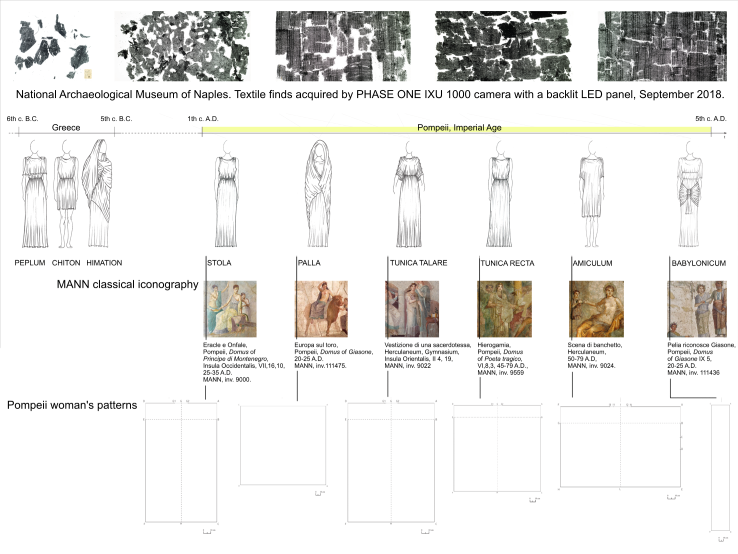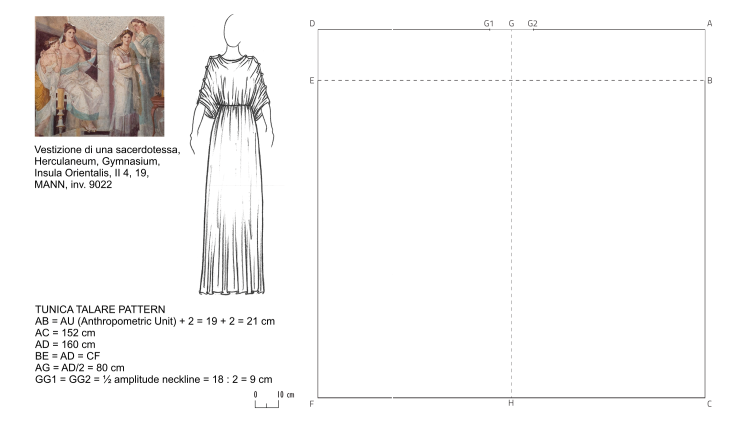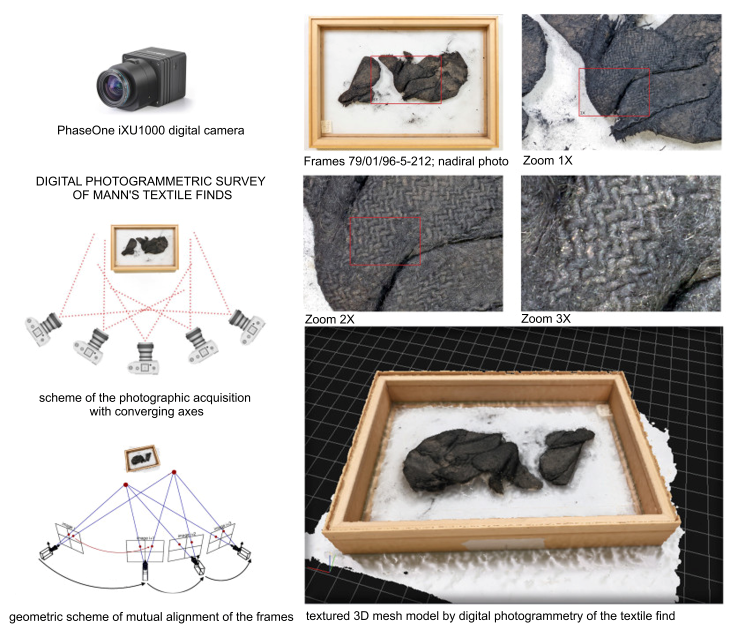1. Introduction
This article presents the results of the research on the women's clothing drawing in use in classical Pompeii, representing fashion and culture in ancient Rome. This research develops a study, actually in progress, on Pompeian clothing (Avella, 2011 [1]; Cirafici et al., 2020 [2]); a study that goes through and puts in relation various disciplines, including the figurative and plastic Arts, Art History of and Historiography, Textile and Fibre Technology, the Chemistry of natural textile dyes, textile processing techniques and technologies and Cultural Anthropology. The aim of this research is to match the information coming from the specific disciplinary studies with those of the Drawing discipline, through the geometric representation of the main women's tailoring patterns and both decorative and chromatic motifs related to the textile fibers used in that period. These drawings add to the preexisting documentation the geometric-dimensional characterization of the Pompeian dresses, breaking the limits of the past and recent scientific literature, which analyzes the topic of the dress and its accessories using specific disciplinary studies where the drawing has a prominent illustrative role rather than critical analysis. The drawing of the Pompeian women's clothing is performed in this research starting from the graphic analysis of the classical iconography of the National Archaeological Museum of Naples (MANN) compared with the historiographical sources, according to a methodological approach of the Drawing discipline. The result is a 'graphic archive' of women's patterns of the leading clothing models used in Pompeii in the classical age; an unprecedented systematic collection of two-dimensional technical drawings (patterns) that codify the unconventional rules that the ancient Romans used for the manufacture of clothes based on knowledge, practical experience and customs (dressing rituals) of the time. The Romans, in fact, to create the different types of clothing, drapped directly the fabric on the body, doing it personally or with the help of a slave (vestiplicus) depending on the social condition, anticipating of few centuries the French tailoring technique of the “moulage”. In the research path, the flat development of each clothing typology is modeled on the geometric rigor of the pattern, is proportionate to the anthropometric measurements of the woman of the Roman age, direct derivation from the anatomical drawing, and is represented scaled.
2. Materials and methods. Vestimenta graphic analysis in classical iconography
Vestimenta drawing used in Pompeii is performed starting from the analysis of the MANN’s classical iconography. The MANN preserves a wide and varied iconographic collection consisting of vascular paintings, frescoes, mosaics, and other figurative elements from the classical period that is a unicum in the world, especially the treasures from the unearthed cities of Herculaneum, Stabia and Pompeii, divided in thematic collections that give the most complete history of ancient painting over thousands of years (Spinazzola, 1928) [3]. Regarding the focus of this research, the figurative elements from the archaeological excavations of Pompeii in the Vesuvian represent a privileged observatory of the main fashion phenomena during the Imperial age in the Roman province and exactly in the period between the first century B.C. and 79 A.D., the year of the tragic eruption of Mount Vesuvius. Throughout human history, clothing and other accessories, including jewellery, had the function of a social insignia for the wearer. Painted and sculptural representations in most cases use precisely clothing and accessories to identify through these the subject in his otherwise anonymous social status. The careful reading of figurative and plastic representations, therefore, can also include the study of the clothing system following the anthropometric information and possibly the chronological and spatial setting of belonging.
The figurative evidence analyzed to obtain useful information for the technical drawing of the tailoring models was selected from the wide MANN’s collection based on the classification, through the study of the human figures on the painted spaces, of all the women’s clothing patterns, and the graphic detail for the description of each clothing type and the related decorative and chromatic motifs, not always clearly visible and therefore recognizable. The graphic analysis was conducted, according to the approach adopted in the discipline of Drawing for the study of iconographic sources, using here less bibliographical references and concentrating on specialized essays on the iconography of the classical period. The result of the analysis is an unprecedented reading, referring first to the wide-ranging and multidisciplinary studies conducted on the clothing system of the Roman era, and in general on the studies conducted on the discipline of Drawing. In fact, the subject develops through thematic studies on the specific competences, giving the possibility to characterize clothing in relation to the History of Art, Textile and Fibre Technology, textile processing techniques and technologies, Restoration of textile artefacts, and cultural anthropology to decode stereotyped rituals of wearing. At the same time, the disciplinary approach of Drawing in relation to classical iconography allows to focus on the reconstruction of ‘painted space’ theorizing perspective constructions apparently of empirical nature, where the methodological history of the representation has knowledge of the vision phenomena making possible to obtain a perfect similarity with represented scenes (Sgrosso, 1984 [4]; Panofsky, 1995, pp. 118-141 [5]; De Rosa et al., 2000 [6]). Pompeii's frescoes, ever since those of the First Style, constitute the main case studies on the representation of the three-dimensionality of space in which, at different scales, the subjects and elements of everyday life are designed according to a very precise geometric-configurative structure underlying the represented scene. Colouristic and luministic effects also influence the verisimilitude of the painted space (Dell’Aquila, 2000 [7]; Pascariello, 2009 [8]; Sofron, 2015 [9]). These studies, however, limit the analysis of the subjects only to their position in the depicted scenes, without considering the in-depth studies used for the constructed space to the human figure or the clothing worn (Fig.1).
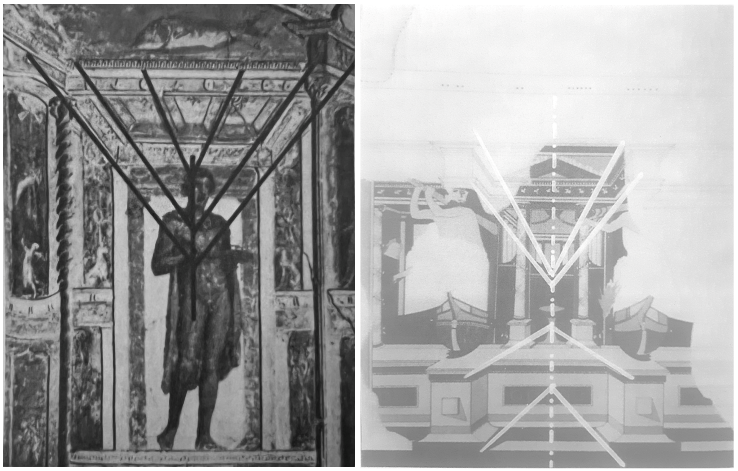
Fig. 1 Perspective reconstruction schemes with a vanishing axis in “Wall painting with stucco decorations. Boscoreale, 1st century A.D.” (left) and in “Wall painting of the cubiculum 42. Pompeii” (right). Source: Panofsky, 1995 (left) [5]; Dell’Aquila, 1999, p. 54 (right) [7].
Therefore, extending the method already tried and tested for the graphic analysis of the spaces represented in classical iconography, to the figures always present in it, the result of the present research is an unpublished collection of two-dimensional technical drawings of clothing types, of which the scientific literature on the subject provides few sartorial descriptions commenting on photographic and archive illustrations, but no technical drawings. The technical drawings integrate with the geometric-dimensional characterization of Pompeian women's clothing the characterizations obtained from studies conducted in other disciplines on the techniques related to the production of textiles, the interpretation of rituals related to the practice of wearing, the social and cultural derivation, the origin of raw materials and natural textile dyes and the necessary journeys through the geographies of ancient times, already systematized in the in ‘Abacus of Pompeian Clothes’ (Avella, 2011) [1]. In the Abacus, the first results of the wider study of which this research is a part, the clothing is the vector for moving through history with its specific characterizations to investigate through the cross-comparison of information, woven like the threads of a weave, the possibility of unexplored interpretations (Fig. 2).
3. The technical drawing of woman’s clothing in the Roman age: from classical iconography to the patterns
The interest showed by the Romans for fashion in the ancient history, and especially in clothing and its accessories, makes possible to follow the development of Roman society from the simple lifestyle of the Republican age to the luxury of the Imperial age (Bonifacio, 2004) [10] through the study of this cultural phenomenon (Simmel, 1985) [11] reflected in style, language, art and in all culture’s fields. In the imperial age the women’s and men's fashion, that in the archaic period were very similar, having only functional purposes, change to adapt to the continuous evolution of trend and traditions and to satisfy the desire for luxury encouraged also by the cancellation of the sumptuary laws issued precisely to contain excessive expenses (Bonamente, 1980) [12].
Pompeian clothing is a clear manifestation of the Roman style and its history strictly connected with the one of the Urbe, starting from the submission to Roman supremacy together with the Campania region at the end of the bloody Samnite Wars (fifth century BC - third century BC). Rome imposed Architecture, Art, Furniture, as well as costume to the provinces of its Empire, to which it was connected by a dense road network. Among the Roman provinces, Pompeii becomes one of the most important commercial ports of Campania.
The descent of Pompeian clothing, on the other hand, from Greek clothing, which in fact connotes it as "Latin-Greek style", derives from and grows in proportion to the expansion of Roman supremacy over the Hellenic colonies and the consequent intensification of commercial relations with the rich Greek cities of the Mediterranean (Candilio, 2004) [13]. The Hellenic cultural influence mainly affects the upper class of the city of Pompeii which expressed it in architecture and fashion.
The Romans adopted from the Greek style the chiton, the himation and the peplum from which the various patterns in use in the Roman provinces and in Pompeii derive. In particular, the woman’s patterns of the tunica, stola and amiculum (like the man’s ones of the toga and tunica) derive from the Greek chiton, while the palla, the traditional wide woman’s cloak, derives from the himation. The Greek chiton, which derives from the peplum worn by women at the beginning of the classical age, has the Doric pattern, simple and short, the Ionic ones, wider than the Doric and long up to the feet, the pattern with false sleeves formed by the apoptygma, and the manicated one with specially sewn tubular sleeves. The Roman clothes are all made from a singlewide cloth, usually rectangular, which is draped directly over the body to obtain long dresses with soft folds, held on the shoulders by buttons (fibulae) and tied at the waist by one or two belts (cinctum). The different clothing patterns that tailor (vestitores) realized on client's commission and that women wore depending on their profession, age, and above all their belonging to a well-defined cultural and social status are distinguished according to the length and width of the fabric, the wearability, the cuts, the seams, the draping (richness of the folds), the number of fibulae, and the wearing of cinctum are distinguished. Each dress extracted from the graphic analysis of the MANN's classical iconography was broken down to identify the different pieces that compose it and their respective decorative haberdashery in order to draw the geometric layouts of the respective patterns.
According to inverse approach to the procedures by which clothes were tailor made in Roman times by draping the fabric directly over the body, in this study the translation of the flat development of the pieces that make up each dress is based on the geometric accuracy of the pattern and to the proportioning of the fashion plate to the anthropometric measurements of the woman (female normotype) of Roman times, considering inseparable relationship between the clothing and the body that wears it, that is between fashion drawing and anatomical drawing through geometry and proportion. In this regard, this study, referring to the literature on this topic and to the results of anthropology research that first provides a systematic analysis of the reliability of the different methods to determine the stature of Italian historical speciments (Giannecchini & Moggi-Cecchi, 2007) [14], assumed as the average female stature (body height) during the Roman period (V century BC - V century AD) the measurement of 152 cm. The latter is calculated with a certain margin of error based on reconstructions of stature starting from skeletons found in the tombs of some archaeological sites in central Italy by means of regression equations based on the relationship between height and bone length of the limbs found, such as humerus, radius, femur and tibia. In detail, the archaeological remains analyzed by the research referred to in this study includes a statistical sample of about 461 female skeletal remains found in 54 archaeological sites, some of which in the Lazio territory.
For the plane projection of the patterns and the proportioning of the technical drawings (plat) of each woman’s pattern to the anthropometry of the woman of the Roman era, this study determines the anthropometric measurements of her the anatomical parts starting from the comparison with the most current Italian woman normotype, to whose anatomical measurements the size chart (standardized measurements) in use today in clothing series manufacturing refers. In particular, the size to which reference is made is size 38 (corresponding to a body height of 152 cm), close in stature to the average woman of the Roman era.
The comparison is possible by the fact that, both in classicism and in the professional fashion drawing, the representation of the human figure underlies a proportional system that, based on the adoption of modular ratios for its sizing, regulates the reciprocal proportions between the measurements of the anatomical parts, and of these with the stature. These geometries of the body inevitably constrain the proportions or the “controlled disproportions” of the dress worn. It should be noted here that the proportioning of the technical drawings to the anthropometry of the woman of the Roman period was an indispensable preparatory step to the drawing of the different patterns analyzed, while being aware that the body constitution (slender or robust) was of little relevance in the manufacture of the clothes in which one was wrapped, according to the dressing rituals of the time.
Finally, the geometric layout of each pattern was drawn to scale by referring to the Roman linear measurement system, anthropometrically based on the Pes Romanus (normalized by Emperor Augustus from 27 BC to 14 AD), which was 29.65 cm (Fig. 3).
4. Ancient textures and contemporary representation: from textile finds to 3D digital model
Women's clothing in Roman period is characterized not only by the geometry of the patterns but also by the richness of the fabrics, the decorative haberdashery, and the splendor of the colors. The textile and dyeing arts are a typical example of how the Romans, great conquerors, knew how to exploit to their advantage all the scientific and technical acquisitions of the peoples they submitted, training specialized artisans who at the time of the kings included, among their various associations, that of dyers (Corti & Giordani, 2001) [15]. Textile craftsmanship, in particular wool art, was one of the leading sectors of the economy among the Romans, as evidenced by the documented existence in Pompeii, at the time of its destruction, of more than thirty laboratories for the processing of textile products, which places it among the most important wool centers in the Mediterranean, with a production capacity that could also satisfy a demand expressed by markets outside its territory. The presence of wool as a raw material in Pompeii is explained and favored by the city's strategic location in the center of the fertile Sarno plain. With a port at the mouth of a navigable river, Pompeii is a natural point of arrival of the sheep-tracks and thus of the flocks of sheep from the transhumant areas and herds (Ciarallo & De Carolis, 1999) [16]. Wool was gradually replaced by more valuable fabrics when the Roman Empire expanded. The Roman conquests, in fact, bringing cultural and political renewal, also affected fashion, which manifested an increased interest in more valuable fabrics for import, especially by the wealthier classes. From Egypt, linen was imported; from Asia Minor, Arabia, Syria, Egypt, and India came cotton fabrics; from China, silk was imported; from the Iberian Peninsula, heavy cloths for winter were imported; from the Greek islands, the finest and most transparent veils was imported; from the Mediterranean Sea, byssus was imported, a silk made from the secretion of a shell that has unfortunately disappeared. If wool was the most common of the animal fibers used in ancient Rome, silk was the most valuable (Martuscelli, 1999) [17], so much so that silk fabrics were often drawn out to make a yarn that, divided into thinner threads, could be woven again with warp threads in linen, wool or blends, so as to reduce the cost and increase the quantity of cloth and consequently the supply. In imperial and medieval Rome, only high dignitaries and women of the aristocracy could afford the luxury of employing the finest fibers in the making of their clothes. Most Romans, on the other hand, in order to follow the current fashion, altered their clothes by changing the color, adding a colored silk flounce, reusing the decorative motifs of a worn-out dress by sewing them on a new one, or changing the babylonicum. It is for this reason that expert in this field include the offectores, artisans assigned to load neutral fabrics with color, and the infectores, who instead change the color. In the officinae infectoriae, particularly prevalent in Pompeii, the fullones, named according to the color produced (spadicari for browns, crocei for yellows, violari for red-violet, porporari for purple), worked at dyeing fibers employing processing techniques that were decidedly advanced for those times, as evidenced by the findings of jars and containers with residues of dyeing matter (Maiuri, 1950) [18] in common dwellings and craft stores in Roman cities around the first century AD.
In Pompeii the eruptive event, suddenly interrupting the daily life left houses, furniture, everyday items and textile finds almost untouched. These historical and archaeological archive materials, as evidence of inestimable value, revealing what was worn and manufactured in everyday life in Pompeii.
The textile finds from Pompeii are part of the "MANN Textile Collection" consisting of about 150 finds mainly from the Vesuvian area. This research was enriched by the outcome of the investigations by the Research Group of the Department of Architecture and Industrial Design (DADI), to which the author belongs. These investigations were conducted before sending the textile finds to the Opificio delle Pietre Dure in Florence for conservation restoration as part of the Research Project aimed at the realization of an exhibition on textile artifacts belonging to the “MANN Textile Collection”.
Specifically, the DADI Research Group under the Scientific coordination of Professor Alessandra Cirafici performed the survey, photographic representation, and photogrammetric restitution of eighteen textile finds mainly in wool, linen, hemp, and silk appropriately selected from those in the Collection by uniqueness and rarity.
The use of more advanced and high-performance investigative technologies (Structure from motion digital photogrammetry) than those available during the first textile finds cataloguing activities, carried out in 1995 by Professor Nicoletta D'Arbitrio, made it possible to continue and integrate the preliminary studies of these textiles.
The high-resolution photorealistic 3D model of each textile finds from the photogrammetric survey becomes the “digital twin” of the real finds, on which both geometric and metric evaluations are carried out in a digital environment.
The scalar visualization of the textile model in the virtual reality of the digital space allows the observer to go into the weft and warp, up to the weft thread and its weave, measure their section or select the volumes, thus overcoming the limits that real space places in the interaction with the textile finds due above all to their fragility (Cirafici et al., 2020) [2] (Fig. 4).
5. Decorative motifs drawing of the Pompeian clothing
Pompeian clothes spun, woven and dyed according to the procedures and techniques of the time were, finally, decorated with different haberdashery depending on the specific pattern. The technical representation of the main women’s tailoring patterns used in Pompeii therefore includes that of the respective decorative and chromatic motifs.
The drawing of the main geometric and / or vegetal decorative motifs recurring in Ancient Rome clothing is the result of the comparison of the graphic analysis of classical iconography and the iconographic collection offered by the late nineteenth-century paintings of Sir Lawrence Alma -Tadema (1836-1912) and John William Godward (1861-1922). Both artists worked at the end of the neoclassical period by re-proposing in their works in general subjects of ancient history, especially Roman. In particular, the works of the Dutch portraitist Sir Lawrence Alma-Tadema were very successful for the effects and the ability of particularly realistic reproduction of fabrics, metals and marbles, such as those of the English painter John William Godward for the meticulous reproduction of the details of the architecture and clothing from the classical era.
The recurring decorative motifs were predominantly geometric - squares, intertwined lozenges and concentric circles - and floral motifs - tendrils, bunches of grapes, buds, acanthus flowers and bushes, palmettes, corymbs, pods, four-, six- and eight-leafed flowers, real or fantastic animals and human figures. These motifs are generated by the repetition of modular elements according to a linear sequence (Zerlenga, 2010) [19], or by the composition and juxtaposition in series of elementary geometric figures such as the circle, the triangle, the square and the hexagon.
To identify the configurative geometries of the decorative motifs of the haberdashery, a comparative analysis was carried out with the contemporary mosaic decorations of the Pompeian domus in which the same decorative motifs are projected on flat supports with horizontal or vertical position and not subject to deformations due to adaptation of the dress of belonging to the sinuosity of the body, in addition to the perspective foreshortenings that the representation of the painted scene imposes. In the Pompeian mosaic decorations, we find the same motifs used by the weavers who reproduced on the cardboard the geometries to be transferred to the loom (Stauffer, 1995) [20].
The decorative motifs found in both the clothing and the coeval ornamental apparatus of the Pompeian domus were studied to analyze the configurative geometries that generated them and represented to scale by proportioning them to the dress and thus to the body wearing it (Fig. 5).
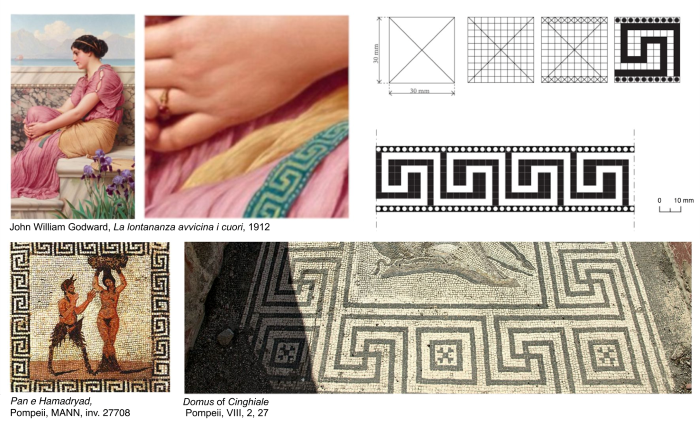
Fig. 5 Drawing decorations in Pompeian clothing and architecture. Geometric motif decorations in the work by John William Godward and in the mosaic floors of domus in Pompeii. Graphic analysis, proportioning and scale redrawing. Source: Drawings, photographic images and graphic elaboration by the author (2020).
6. Conclusions
The observations that emerged from the first results of this research highlight the essential role that drawing also offers to the subject of clothing in Roman times and confirm the centrality of the geometric criterion not only in the graphic analysis of the scenes represented in the iconographic sources references, but also in the analysis of the subjects in them and the clothing worn. Geometry underlies the scaled representation of patterns of different clothing types; it is the theoretical foundation of traditional or three-dimensional digital survey methods adopted for the analysis of textile finds; it regulates the principles through which the configurative matrices of the decorative motifs in the Pompeian clothing are generated; it adapted the clothing to the body that wears it according to the geometric theories that have characterized the first fashion drawing since antiquity, that of the human body.
The research’s progress will interest the 3D modeling of each dress type whose geometry is parametric directly derived from the parametricity of the body; and the hypothesis of scheduling 2D technical drawings and 3D models of the woman’s Pompeian patterns in the Catalogue of the Central Institute for Catalogue and Documentation (ICCD).
Acknowledgements
This research on the Roman clothing’s drawing is part of a larger study started with the PRIN Research 2007/2009, witch results were published in the Volume titled Luoghi Mediterranei (Avella, 2011) [1] and followed up under the agreement promoted by the National Archaeological Museum of Naples (MANN) and the Department of Architecture and Industrial Design of the University of Campania Luigi Vanvitelli (Scientific Coordinators L. Melillo and A. Cirafici), having as its subject the Research Project aimed for the realization of an exhibition on textile artifacts belonging to the “MANN Textile Collection”, the results of which were presented at The 2ND International Conference on Textiles, Identity and Innovation (D_TEX2019) held in Lisbon, Portugal, from 19-21 June 2019 (Cirafici et al., 2020) [2].














